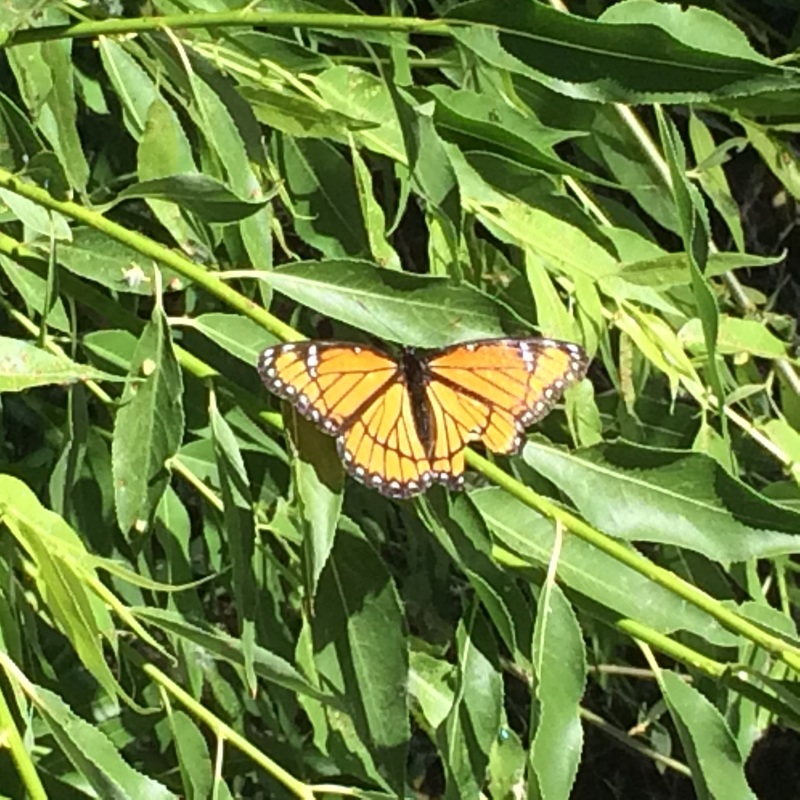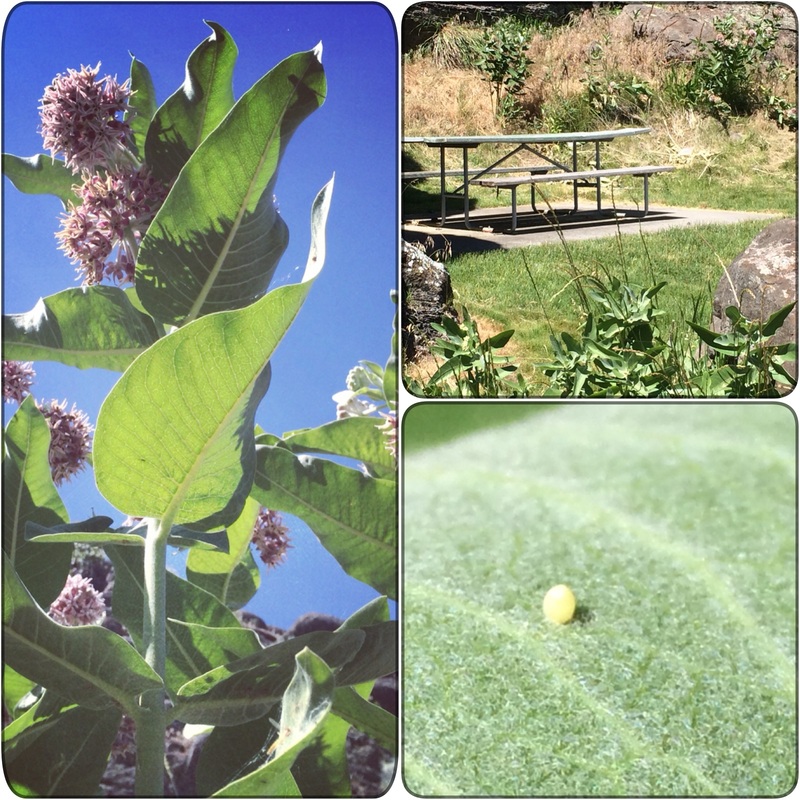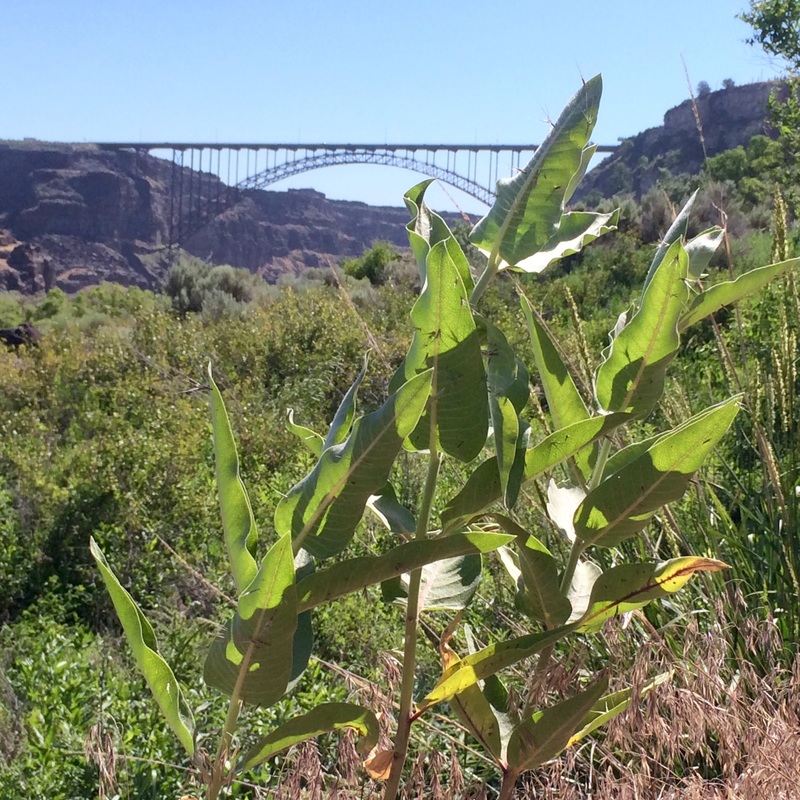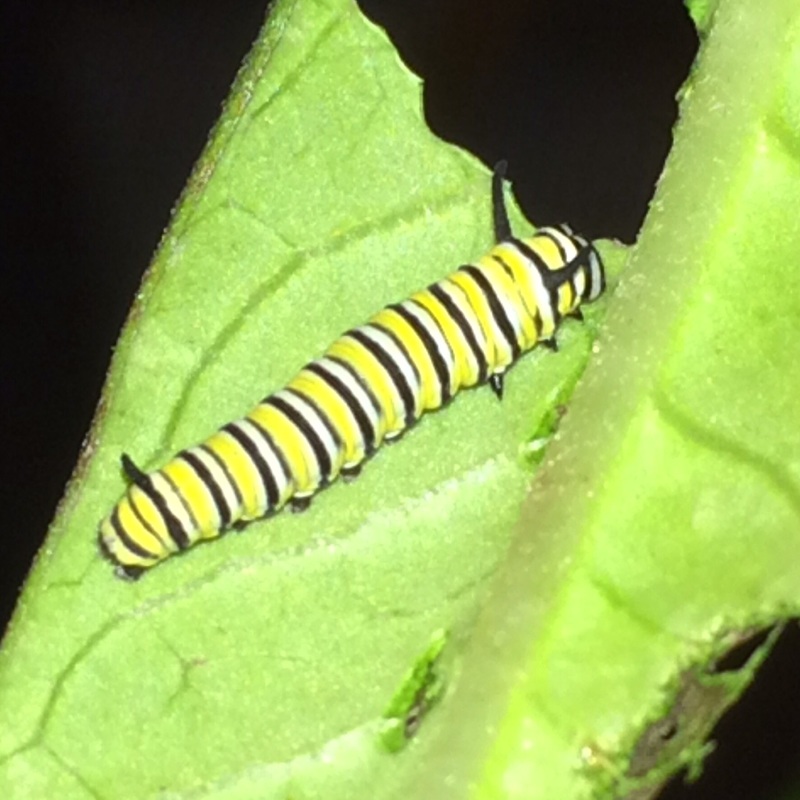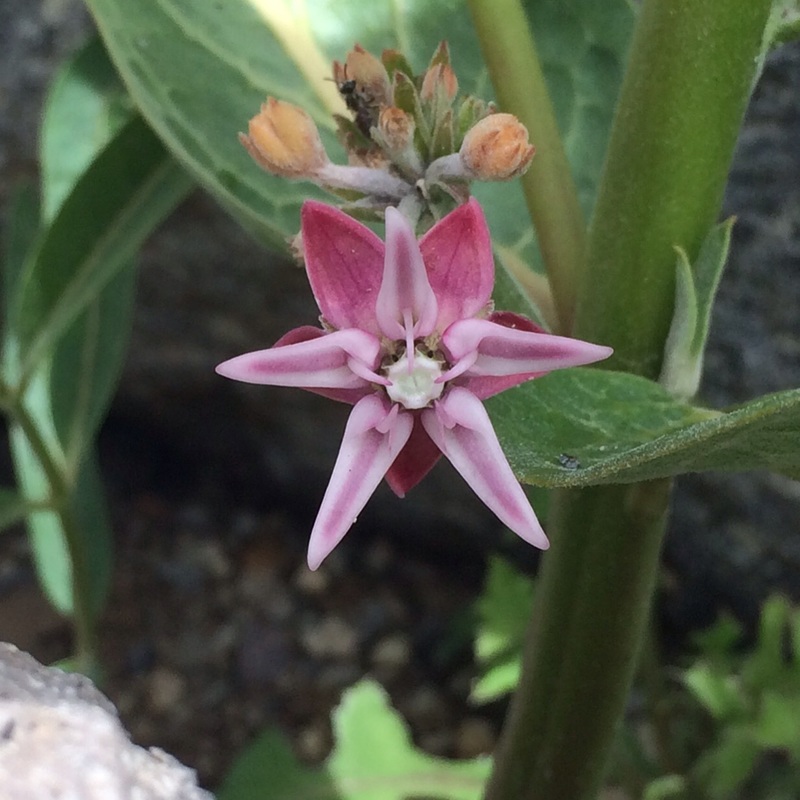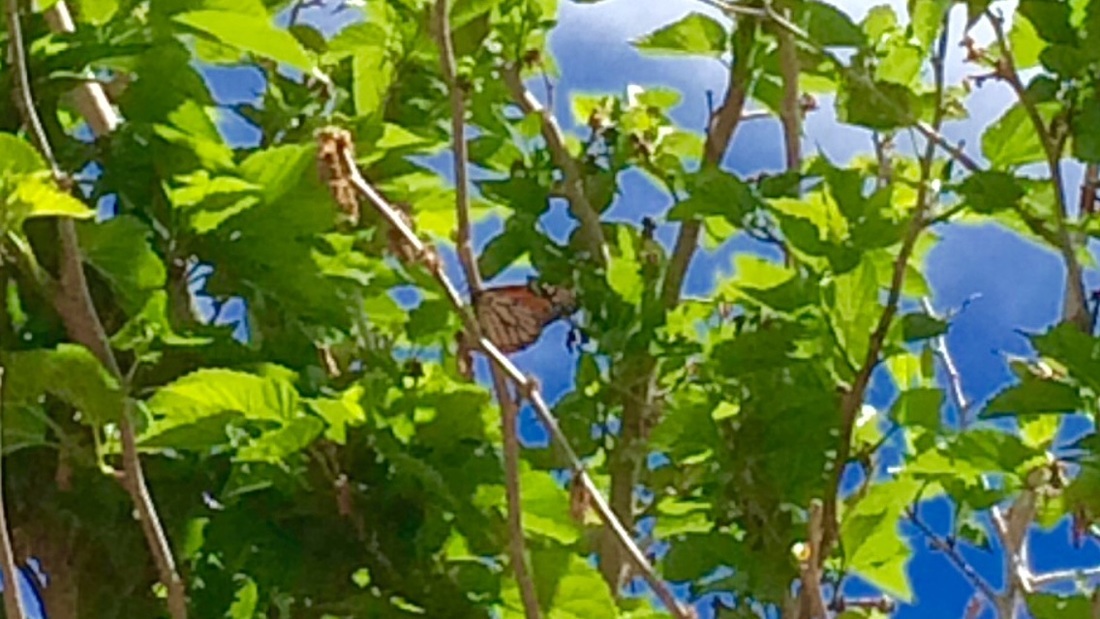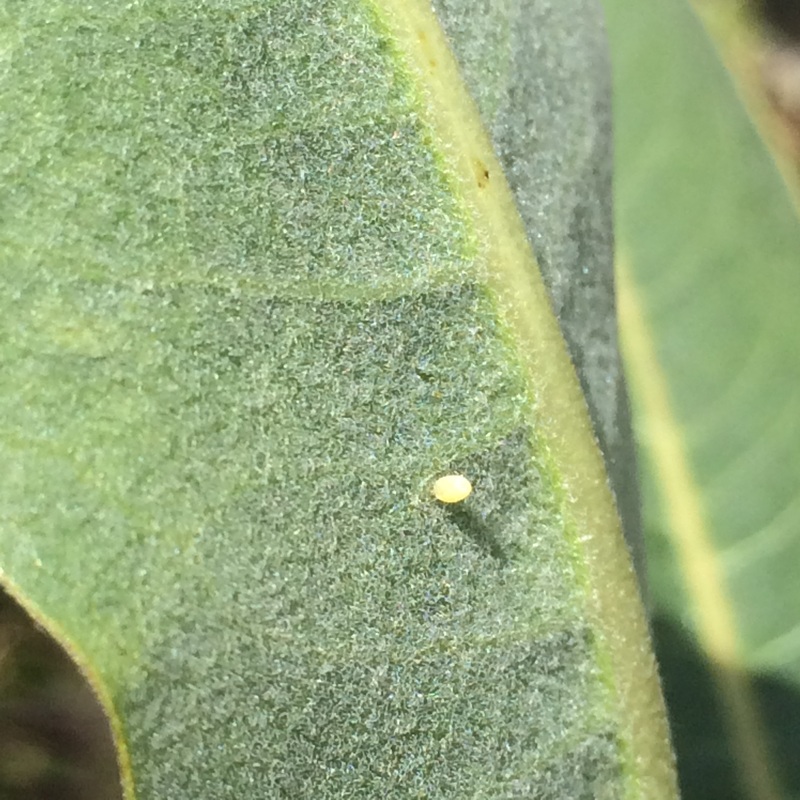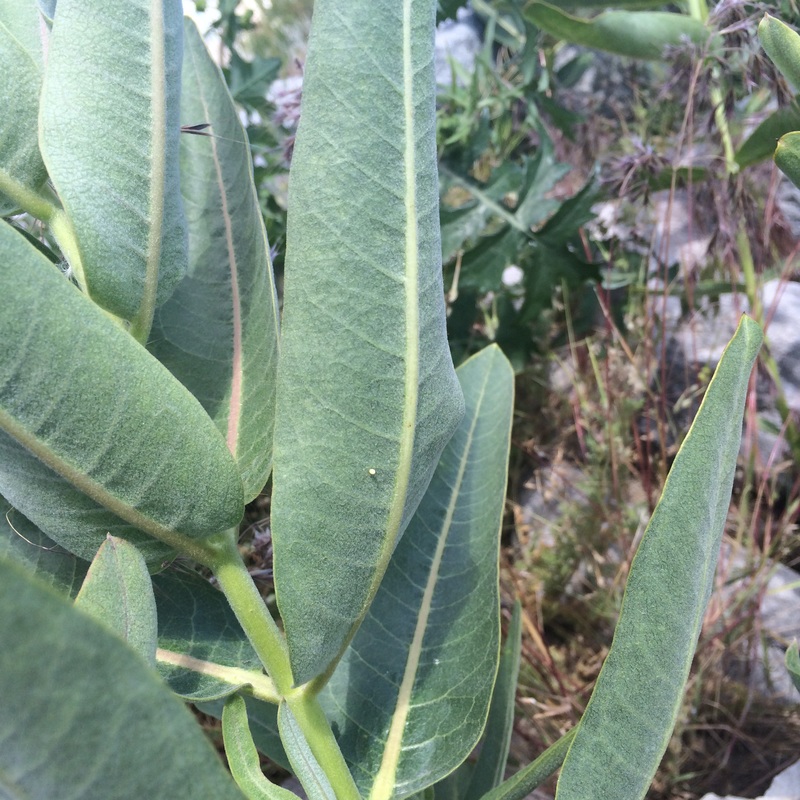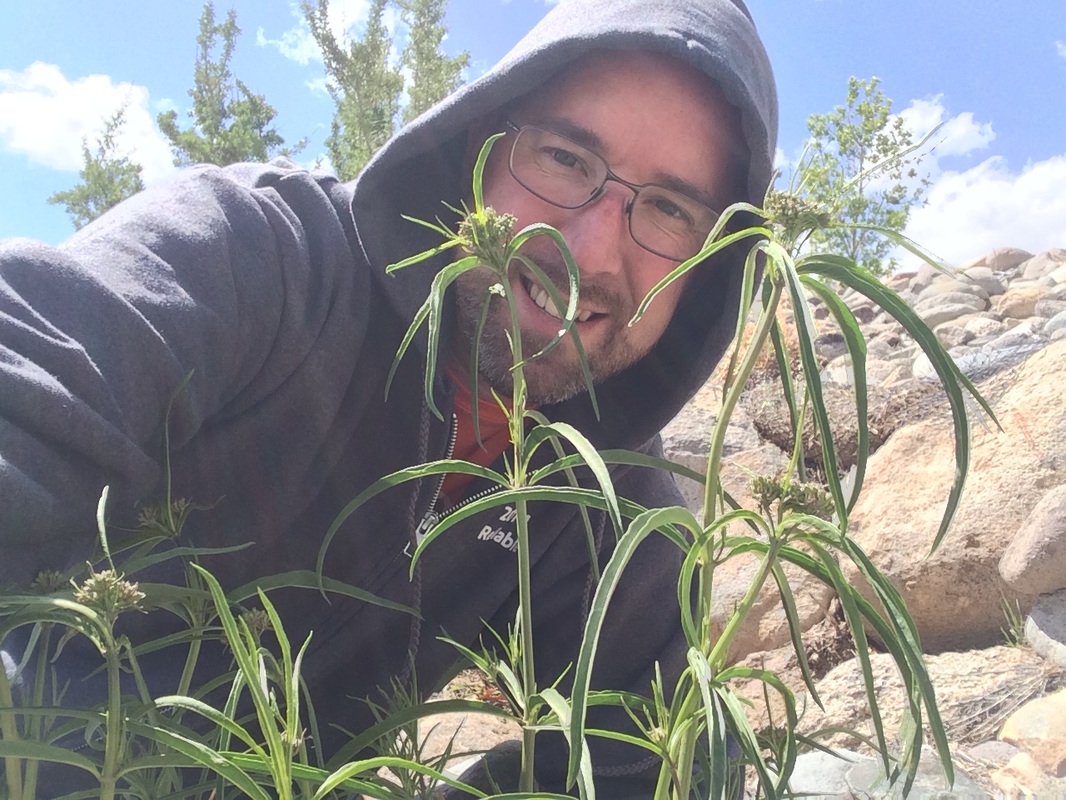|
Monarch's are now all over North America. Mexico has monarchs. America has monarchs. Canada has monarchs. Summertime is primetime for monarchs to migrate. Use the milkweed locater to see which type of milkweed is native to your state. Monarchs are not on My Milkweed, Why?The distribution of monarchs can appear to be uneven at times. I am happy to have seen a total of three monarchs in my yard this year. It is still early in the monarch's migration season. No eggs have been laid on my milkweed yet. The milkweed patch is a busy habitat for hundreds of animals that visit the plant throughout the summer. Bees are actively pollinating the blooms. Spiders are laying in wait for tiny bugs. Tiny bugs are striving to survive on the milkweed plants. One of the smallest animals on milkweed is the monarch caterpillar. Caterpillars can be very difficult to see when they are small. A newly hatched caterpillar is only 2-6mm in length (source: Monarch Watch) and nearly transparent. The day after my latest caterpillar hatched I didn't see it on the milkweed until two days later. They could be hiding out in the open. Monarchs need time to reproduceThe monarch lifecycle is an amazing process. Metamorphosis is incredibly complex and requires that many steps in the process goes well for the monarch to take flight. An entire metamorphosis from egg to butterfly occurs in about 30 days. As monarchs enter your region of N. America they may be at the end of their short life. An egg laying female is likely to lay as many as 500 eggs on the milkweed plants in her lifetime. Those eggs take about a week to hatch the tiny caterpillar. It may be another week before you notice the leaves being chewed up by the hungry caterpillars. Once the caterpillars have grown thru five instars they may have crawled away from the milkweed to form the chrysalis. The chrysalis is the last step in metamorphosis before the butterfly takes flight. As fun as looking for monarchs in flight can be, we may be looking in the wrong place. Egg, caterpillar and chrysalis are also monarchs that haven't gotten ready to fly. Take some time to look at the milkweed throughly. Eggs are small, oblong and have a light gold color. You may find an egg before you see a monarch. Monarch eggs in Twin Falls, IdahoWhile traveling to attend a wedding visited a park that I went to in 2014. There was milkweed in the park in 2014 so I was hopeful to find monarchs in 2015. While I did not see any monarchs, I did see a viceroy butterfly.
Raising monarchs at homeIn one month a monarch can be raised in your home. With a little preparation and a lot of patience you can contribute to the monarch butterfly population explosion that is overdue. I have a goal to raise and release twenty-five healthy monarch butterflies in 2015. The most natural approach to supporting monarchs is to grow milkweed on your property. Monarch waystations and pollinator gardens are hugely successful and provide wonderful habitats for monarchs and other beneficial insects. Currently I am growing milkweed in a monarch waystation. The name of my way station is "The Biggest Little Butterfly Garden In The World" Monarch waystation #8269 as registered with the Monarch Watch Waystation Program. Registering your garden is not necessary. I chose to register and even ordered the cool sign. I consider it a donation to a good cause. The monarchs habitat is a cruel unforgiving place to grow up. Spending a month outside in the elements is dangerous, even in the summer, for a monarch larvae. Eggs get eaten, caterpillars become meals. Chrysalids can become damaged. Any one of these events will kill that monarch larvae. To control the process I am trying to raise this years 25 monarchs indoors. By preventing eggs from being eaten. Keeping caterpillars from becoming meals. And by hosting the chrysalids in a safe place I plan to increase the survival rate from a dismal 5% to above 75%. Some folks raising monarchs report successful rearing of above 95%. By removing a few variable from the environment the monarchs stand a better chance of completing their metamorphosis. From One to Twenty-Five in only One Year
2 Comments
Monarch Season is in Full BloomWinter monarchs have entirely disbanded from their clusters and are crossing all international boarders. Canada has seen the arrival of the the first flying flowers. A few weeks behind these northern flyers are their offspring. As the monarchs are flying around pollinating they are also in search of milkweed. Milkweed is in full bloom. Most of the milkweed is ready for monarch caterpillars. Milkweed is rapidly growing all over North America. The monarchs are doing what they do best. Monarchs are laying their tiny eggs and a new generation is emerging to continue the migration.
Current Monarch Butterfly Activity in RenoNevada monarchs are believed to be a part of the western population of monarchs. The western monarchs are identical to the eastern monarchs in almost every way. The only difference is where they go during the winter. Western monarchs go west to over 200 locations in central and southern California. Warm weather is becoming more common across America. Monarchs love the warm weather. Have you been outdoors observing monarch activity? Its truly incredible. Monarchs have become very active in the northern Nevada area around Reno.
Beginning in June monarch sightings become much more frequent. To spot a monarch I find that looking toward the nearest milkweed plant is a good place to begin. Monarch butterflies flutter all around the milkweed. They know it is home. The female monarch will lay her eggs on the plant. June, July and August are the peak season for Monarch butterflies in most places. If you have milkweed in your garden then you may have monarchs as guests in your garden. Another option to find monarchs is to go out looking for them. Maybe a park or field edge has milkweed? It will certainly be a good place to begin looking. How are the Monarch's where you are?Tell about your experience seeing monarchs, eggs, caterpillars or chrysalis this year. Was it in your yard or were you traveling? Do you raise the butterflies and release them? Leave a link to your favorite monarch resource to help others conserve this insect.
|
Site SearchAuthorMake milkweed your friend. Your friends will love your milkweed. My name is Brad. Learn more about me now. Blog Archives
March 2022
Blog Categories
All
email Subscriber archive |
-
Home
- About
- Why Grow Milkweed Plants
- Contact
-
Map
>
-
USA
>
- Alabama
- Alaska
- Arizona
- Arkansas
- California
- Colorado
- Connecticut
- Delaware
- District of Columbia
- Florida
- Georgia
- Hawaii
- Idaho
- Illinois
- Indiana
- Iowa
- Kansas
- Kentucky
- Louisiana
- Maine
- Maryland
- Massachusetts
- Michigan
- Minnesota
- Mississippi
- Missouri
- Montana
- Nebraska
- Nevada
- New Hampshire
- New Jersey
- New Mexico
- New York
- North Carolina
- North Dakota
- Ohio
- Oklahoma
- Oregon
- Pennsylvania
- Rhode Island
- South Carolina
- South Dakota
- Tennessee
- Texas
- Utah
- Vermont
- Virginia
- Washington
- West Virginia
- Wisconsin
- Wyoming
- Canada >
- Mexico >
-
USA
>
- FAQ
-
Milkweed
- Aquatic milkweed, Asclepias perennis
- Arizona milkweed, Asclepias angustifolia
- Bear mountain milkweed, Asclepias scaposa
- Bract milkweed, Asclepias brachystephana
- Broadleaf milkweed, Asclepias latifolia
- Butterfly milkweed, Asclepias tuberosa
- California milkweed, Asclepias californica
- Carolina milkweed, Asclepias cinerea
- Clasping milkweed, Asclepias amplexicaulis
- Common milkweed, Asclepias syriaca
- Curtiss' milkweed, Asclepias curtissii
- Cutler's milkweed, Asclepias cutleri
- Desert milkweed, Asclepias erosa
- Dwarf milkweed, Asclepias involucrata
- Emory's milkweed, Asclepias emoryi
- Engelmann's milkweed, Asclepias engelmanniana
- Fewflower milkweed, Asclepias lanceolata
- Florida milkweed, Asclepias feayi
- Fourleaf milkweed, Asclepias quadrifolia
- Green antelopehorn, Asclepias viridis
- Green Comet milkweed, Asclepias viridiflora
- Greene's milkweed, Asclepias californica ssp. greenei
- Hall's milkweed, Asclepias hallii
- Heartleaf milkweed, Asclepias cordifolia
- Horsetail milkweed, Asclepias subverticillata
- Jewel milkweed, Asclepias cryptoceras
- Largeflower milkweed, Asclepias connivens
- Lemmon's milkweed, Asclepias lemmonii
- Longhood milkweed, Asclepias macrotis
- Longleaf milkweed, Asclepias longifolia
- Mahogany milkweed, Asclepias hypoleuca
- Mead's milkweed, Asclepias meadii
- Mexican whorled milkweed, Asclepias fascicularis
- Michaux's milkweed, Asclepias michauxii
- Mojave milkweed, Asclepias nyctaginifolia
- Nodding milkweed, Asclepias glaucescens
- Oval-leaf milkweed, Asclepias ovalifolia
- Parish's woolly milkweed, Asclepias vestita
- Pineland milkweed, Asclepias obovata
- Pineneedle milkweed, Asclepias linaria
- Pinewoods milkweed, Asclepias humistrata
- Plains milkweed, Asclepias pumila
- Poke milkweed, Asclepias exaltata
- Prairie milkweed, Asclepias sullivantii
- Prostrate milkweed, Asclepias prostrata
- Purple milkweed, Asclepias purpurascens
- Red milkweed, Asclepias rubra
- Redring milkweed, Asclepias variegata
- Rusby's milkweed, Asclepias rusbyi
- Rush milkweed, Asclepias subulata
- Ruth's milkweed, Asclepias uncialis
- Sand milkweed, Asclepias arenaria
- Savannah milkweed, Asclepias pedicellata
- Serpentine milkweed, Asclepias solanoana
- Showy milkweed, Asclepias speciosa
- Sidecluster milkweed, Asclepias lanuginosa
- Slim milkweed, Asclepias linearis
- Slimleaf milkweed, Asclepias stenophylla
- Slimpod milkweed, Asclepias quinquedentata
- Southern milkweed, Asclepias viridula
- Sperry's milkweed, Asclepias sperryi
- Spider milkweed, Asclepias asperula
- Swamp milkweed, Asclepias incarnata
- Swamp milkweed, Asclepias incarnata ssp. pulchra
- Tall green milkweed, Asclepias hirtella
- Texas milkweed, Asclepias texana
- Tuba milkweed, Asclepias tomentosa
- Tufted milkweed, Asclepias nummularia
- Utah milkweed, Asclepias labriformis
- Welsh's milkweed, Asclepias welshii
- Wheel milkweed, Asclepias uncialis
- Whitestem milkweed, Asclepias albicans
- Whorled milkweed, Asclepias verticillata
- Woolly milkweed, Asclepias vestita
- Woollypod milkweed, Asclepias eriocarpa
- Zizotes milkweed, Asclepias oenotheroides
- Store
- Podcast
- Blog
- Resources
-
Home
- About
- Why Grow Milkweed Plants
- Contact
-
Map
>
-
USA
>
- Alabama
- Alaska
- Arizona
- Arkansas
- California
- Colorado
- Connecticut
- Delaware
- District of Columbia
- Florida
- Georgia
- Hawaii
- Idaho
- Illinois
- Indiana
- Iowa
- Kansas
- Kentucky
- Louisiana
- Maine
- Maryland
- Massachusetts
- Michigan
- Minnesota
- Mississippi
- Missouri
- Montana
- Nebraska
- Nevada
- New Hampshire
- New Jersey
- New Mexico
- New York
- North Carolina
- North Dakota
- Ohio
- Oklahoma
- Oregon
- Pennsylvania
- Rhode Island
- South Carolina
- South Dakota
- Tennessee
- Texas
- Utah
- Vermont
- Virginia
- Washington
- West Virginia
- Wisconsin
- Wyoming
- Canada >
- Mexico >
-
USA
>
- FAQ
-
Milkweed
- Aquatic milkweed, Asclepias perennis
- Arizona milkweed, Asclepias angustifolia
- Bear mountain milkweed, Asclepias scaposa
- Bract milkweed, Asclepias brachystephana
- Broadleaf milkweed, Asclepias latifolia
- Butterfly milkweed, Asclepias tuberosa
- California milkweed, Asclepias californica
- Carolina milkweed, Asclepias cinerea
- Clasping milkweed, Asclepias amplexicaulis
- Common milkweed, Asclepias syriaca
- Curtiss' milkweed, Asclepias curtissii
- Cutler's milkweed, Asclepias cutleri
- Desert milkweed, Asclepias erosa
- Dwarf milkweed, Asclepias involucrata
- Emory's milkweed, Asclepias emoryi
- Engelmann's milkweed, Asclepias engelmanniana
- Fewflower milkweed, Asclepias lanceolata
- Florida milkweed, Asclepias feayi
- Fourleaf milkweed, Asclepias quadrifolia
- Green antelopehorn, Asclepias viridis
- Green Comet milkweed, Asclepias viridiflora
- Greene's milkweed, Asclepias californica ssp. greenei
- Hall's milkweed, Asclepias hallii
- Heartleaf milkweed, Asclepias cordifolia
- Horsetail milkweed, Asclepias subverticillata
- Jewel milkweed, Asclepias cryptoceras
- Largeflower milkweed, Asclepias connivens
- Lemmon's milkweed, Asclepias lemmonii
- Longhood milkweed, Asclepias macrotis
- Longleaf milkweed, Asclepias longifolia
- Mahogany milkweed, Asclepias hypoleuca
- Mead's milkweed, Asclepias meadii
- Mexican whorled milkweed, Asclepias fascicularis
- Michaux's milkweed, Asclepias michauxii
- Mojave milkweed, Asclepias nyctaginifolia
- Nodding milkweed, Asclepias glaucescens
- Oval-leaf milkweed, Asclepias ovalifolia
- Parish's woolly milkweed, Asclepias vestita
- Pineland milkweed, Asclepias obovata
- Pineneedle milkweed, Asclepias linaria
- Pinewoods milkweed, Asclepias humistrata
- Plains milkweed, Asclepias pumila
- Poke milkweed, Asclepias exaltata
- Prairie milkweed, Asclepias sullivantii
- Prostrate milkweed, Asclepias prostrata
- Purple milkweed, Asclepias purpurascens
- Red milkweed, Asclepias rubra
- Redring milkweed, Asclepias variegata
- Rusby's milkweed, Asclepias rusbyi
- Rush milkweed, Asclepias subulata
- Ruth's milkweed, Asclepias uncialis
- Sand milkweed, Asclepias arenaria
- Savannah milkweed, Asclepias pedicellata
- Serpentine milkweed, Asclepias solanoana
- Showy milkweed, Asclepias speciosa
- Sidecluster milkweed, Asclepias lanuginosa
- Slim milkweed, Asclepias linearis
- Slimleaf milkweed, Asclepias stenophylla
- Slimpod milkweed, Asclepias quinquedentata
- Southern milkweed, Asclepias viridula
- Sperry's milkweed, Asclepias sperryi
- Spider milkweed, Asclepias asperula
- Swamp milkweed, Asclepias incarnata
- Swamp milkweed, Asclepias incarnata ssp. pulchra
- Tall green milkweed, Asclepias hirtella
- Texas milkweed, Asclepias texana
- Tuba milkweed, Asclepias tomentosa
- Tufted milkweed, Asclepias nummularia
- Utah milkweed, Asclepias labriformis
- Welsh's milkweed, Asclepias welshii
- Wheel milkweed, Asclepias uncialis
- Whitestem milkweed, Asclepias albicans
- Whorled milkweed, Asclepias verticillata
- Woolly milkweed, Asclepias vestita
- Woollypod milkweed, Asclepias eriocarpa
- Zizotes milkweed, Asclepias oenotheroides
- Store
- Podcast
- Blog
- Resources

